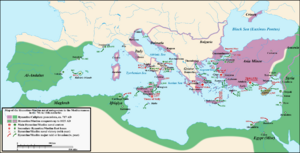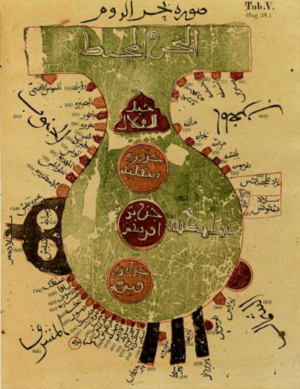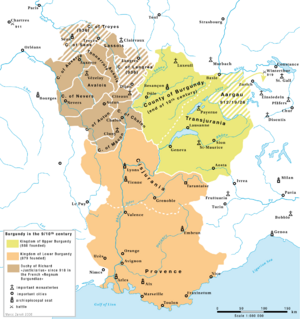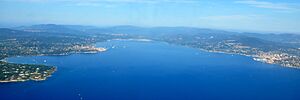Fraxinetum facts for kids
Fraxinetum or Fraxinet was the name of a strong Muslim base in Provence, a region in what is now France. This base was active for about 85 years, from around 887 to 972. It is believed to be located where the modern town of La Garde-Freinet stands today, close to Saint-Tropez.
The name Fraxinetum comes from the Latin word fraxinus, which means "ash tree." So, Fraxinetum likely meant "ash forest." This area was settled by Muslims who came from al-Andalus, which was Muslim-controlled Spain. From this base, they launched raids into the Rhône Valley, Piedmont (in Italy), and even as far as the Abbey of Saint Gall (in Switzerland). They were known for capturing people to sell as slaves in Islamic markets. For a time, they controlled important mountain passes in the western Alps. Even though many tried to remove them, they were finally defeated by a combined army of nobles from Provence and Piedmont at the battle of Tourtour in 972.
Contents
Where Was Fraxinetum Located?
The fort of Fraxinetum was built on top of a hill called Mont des Maures. This hill overlooked what is now the village of La Garde-Freinet. The fort had been there since the time of the Roman Empire. Its name comes from the Latin word for "ash tree," probably because the hill was covered with many ash trees.
Muslim geographers like al-Iṣṭakhrī and Ibn Ḥawqal called Fraxinetum Jabal al-Qilāl, meaning "mount of timber." They described the Muslim area as very large, with many streams and fertile land. They said it would take two days to cross it. Ibn Ḥawqal mistakenly thought it was an island at the mouth of the Rhône river.
Who Lived in Fraxinetum?
The people of Fraxinetum were connected to the Caliphate of Córdoba, a powerful Muslim state in Spain. Historical writings describe them in different ways. Some called them Saracens from Spain, while others simply called them Spaniards. They were also sometimes called "blacks," "heathens," or Hagarenes.
Historian Mohammad Ballan suggests that Fraxinetum was more than just a settlement. It was a border state that was important for both its economy and its military strength in the region.
How Did Fraxinetum Begin and Grow?
Early Raids in the Region
Before Fraxinetum was established, there were already Muslim raids in the area. In 838, records show that Muslims raided Marseille. They took valuable items from religious buildings and captured people as slaves. In 842, there was another raid near Arles. In 869, raiders returned to Arles and captured the archbishop, Roland. They demanded money for his release, but he died before he was handed over. These raids up the Rhône river might have encouraged the raiders to look for places further east, leading to the permanent base at Fraxinetum.
Establishing the Stronghold
The Muslim presence in Fraxinetum started around 887. A small ship with about twenty sailors from Spain landed near Saint-Tropez. These sailors took control of the settlement at the bottom of the hill, and then the fort itself. The fort could only be reached by a narrow path through the thick forest.
The settlers sent messages back to Spain and the Balearics (islands in the Mediterranean) asking for more fighters. About 100 warriors joined them, driven by their faith and the desire for riches. In their first twenty years, the Muslims of Fraxinetum took control of Provence. They also began raiding across the Alps into Italy. Their quick success was partly due to the disagreements among the local Provençal leaders after the Carolingian empire weakened.
By 906, they controlled the Mont Cenis pass, an important route between Provence and Italy. That year, they attacked or took over towns in Italy like Acqui, Oulx, and Susa. By 911, they controlled all the western Alpine passes. This allowed them to charge tolls to traders and pilgrims. Between 915 and 918, they raided Embrun, Maurienne, and Vienne. In 920, they attacked Italy again, as well as Marseille and Aix-en-Provence in western Provence.
Between 929 and 933, the Muslims of Fraxinetum expanded their control to more eastern Alpine passes. They also raided the Upper Rhône Valley. In 939, they crossed the Alps again and attacked the Abbey of Saint Gall and destroyed the Abbey of Saint-Maurice d'Agaune. Like the Vikings of that time, the Muslim raiders often targeted monasteries because they were wealthy and not well-protected.
The Slave Trade and Its Impact
Fraxinetum became an important part of the al-Andalus slave trade. People living in the area often fled in fear of these raids. This made it hard for the Frankish rulers to protect their southern coast. The Muslims of Fraxinetum captured Frankish prisoners and sold them as slaves to slave markets in the Muslim Middle East.
Fraxinetum's Strongest Period
Men from Fraxinetum might have taken part in the Fatimid raid on Genoa in 935. They definitely destroyed the port of Fréjus in 940. This led King Hugh of Italy to act. In 941 or 942, he sought an alliance with the Byzantine Empire. The Byzantine Emperor Romanos Lekapenos agreed. While Hugh attacked Fraxinetum by land, a Byzantine fleet used Greek fire to destroy the Muslim ships.
Just as Fraxinetum was about to surrender, Hugh received news that a rival, Berengar of Ivrea, was planning to invade Italy. Hugh stopped the siege and made a deal with the Muslims. They were allowed to keep the Alpine passes, likely in exchange for defending Italy's border. Hugh's sudden change in plans might also have been connected to trade agreements he made with the Umayyad caliphate around the same time.
Christian writers at the time criticized Hugh's decision. They blamed him for the deaths of many Christians. In the 940s, Fraxinetum was at its most powerful. It even gave shelter to some Christian rebels. After he lost his power in 962, King Adalbert of Italy found safety in Fraxinetum. Records from 951 state that "the Saracens occupying the Alpine passes extract tribute from travellers to Rome, only thus allowing them to pass."
Around 954, Fraxinetum had a conflict with Hungarian invaders. King Conrad of Burgundy took advantage of this to attack both sides. The major defeat of the Hungarians by King Otto I of Germany at the Battle of Lechfeld the next year allowed Otto to focus on the threat from Fraxinetum. A military expedition might have been planned, but it never happened.
Decline and Final Defeat
In 956, a raid into the Upper Rhine Valley led Otto I to send a message to the Umayyad court. He believed they could control Fraxinetum. This raid deep into Otto's territory was a "major miscalculation" for Fraxinetum. After this, the support from Spain to Fraxinetum greatly decreased.
In 972, the Muslims captured Abbot Maiolus of Cluny while he was crossing the Alps and held him for ransom. After Maiolus was released, he organized a military response. Led by Count William I of Provence and Count Arduin of Turin, a Christian army from Provence, Piedmont, and Septimania defeated the Muslims in the battle of Tourtour in the summer of 972. Fraxinetum fell by the end of that year after a short siege.
After Fraxinetum fell, Muslims who did not leave were either killed or sold into slavery. Many converted to Christianity and stayed in Provence as farm workers. The lands that were once controlled by Muslims were then divided among the victorious Provençal nobles.
How Was Fraxinetum Governed?
The Muslims of Fraxinetum built forts throughout the areas they conquered in Provence and Piedmont. However, old Latin writings often called all these forts by the name Fraxinetum or similar names. They built a line of forts across the Alps to control the mountain passes and use them as bases for raids.
The Muslim rule in Fraxinetum was not direct. Christians were allowed to keep their religion and towns could govern themselves. They did this by agreeing to the dhimma (a pact of submission) and paying the jizya (a special tax). The main goal of the conquerors was "the capture of Europeans for the slave markets of the Islamic world."
Archaeological findings, like 10th-century Muslim shipwrecks off the coast of Provence, suggest that Fraxinetum had trade connections with other parts of the Muslim world.
Timeline of Fraxinetum
- 889: About twenty people from Spain sail into the Gulf of St. Tropez and start a settlement at Fraxinetum.
- 906: People from Fraxinetum cross the mountain passes of Dauphiné and Mont Cénis.
- 908: They take control of the Susa Valley.
- 911: They hold the Alpine passes.
- 929: Fraxinetum forces reach the borders of Liguria.
- 935: Sa'id dies at the Battle of Acqui.
- 940: People from Fraxinetum occupy and settle in Toulon.
- 942: They establish settlements at Nice and Grenoble.
- 970: They leave Grenoble, Savoy, and Gap.
- 972: They capture Majolus of Cluny at the Great St Bernard Pass.
- 973: After the Battle of Tourtour, they leave Fraxinetum.
- 1047: A raid by people from Spain on Lérins Islands.
See also
 In Spanish: Fraxinetum para niños
In Spanish: Fraxinetum para niños





